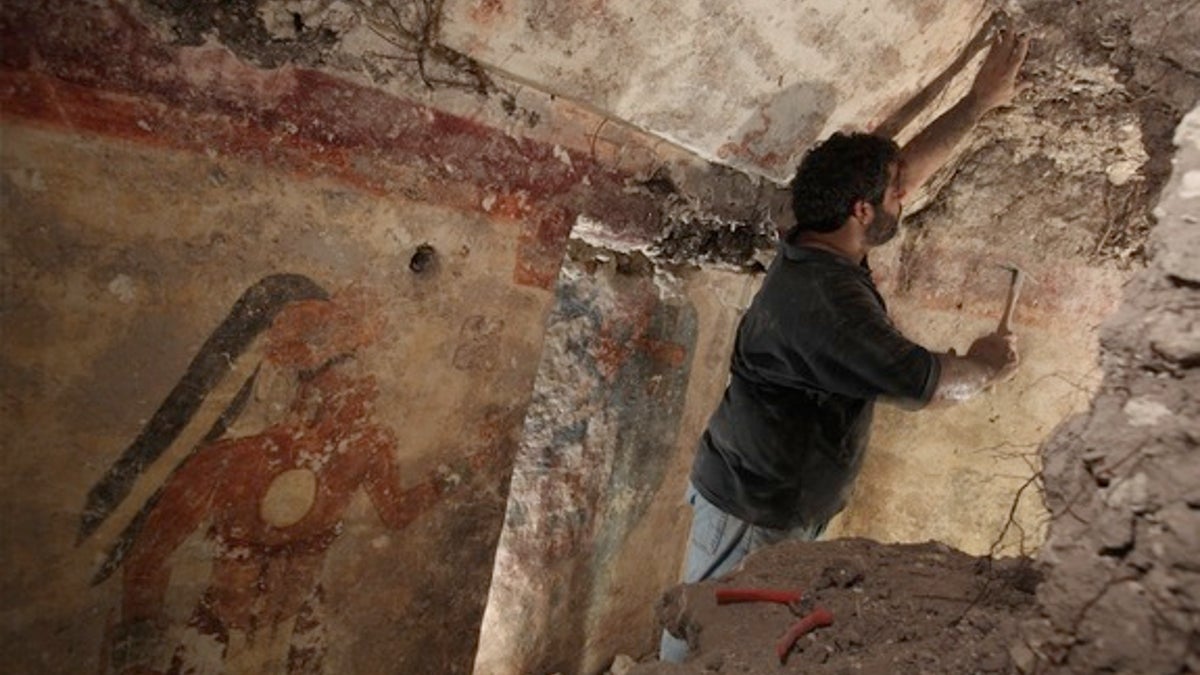
Archaeologist William Saturno of Boston University carefully uncovers art and writings left by the Maya some 1,200 years ago. The art and other symbols on the walls may have been records kept by a scribe, Saturno theorizes. (Tyrone Turner © 2012 National Geographic)
The end is near, according to some — but experts say not to put stock in the Mayan Apocalypse rumors that claim the world will end on Friday.
The date, Dec. 21, 2012, corresponds with the end of the 13th b'ak'tun of the ancient Maya Long Count Calendar. This calendar is one of several developed by the Central American empire that collapsed around A.D. 900. The 400-year-long b'ak'tun is only one of the units of time the Maya used to mark cycles in their calendar, according to University of Texas Maya hieroglyph expert David Stuart. The complex, cyclical calendar included at least 24 different units of time both shorter and longer than b'ak'tuns, Stuart said.
[pullquote]
That doesn't mean, however, that the Maya believed the world would end at the completion of the 13th b'ak'tun. The oldest Maya calendar painting ever discovered, for example, includes calculations of 17 b'ak'tuns. And the Maya had 24 units of time they included in their calendar, according to University of Texas Maya hieroglyph expert David Stuart, with b'ak'tuns representing only one unit. In other words, the Maya were well-prepared to record thousands upon thousands of years of time.
Doomsday rumors arose only when a handful of Westerners got hold of the Maya calendar concept in the 1980s and 1990s, said Lorenzo DiTommaso, a professor of religion at Concordia University in Montreal. Either misunderstanding or intentionally ignoring the Mayans' cyclical view of time, these writers interpreted the end of the 13-b'ak'tun cycle "in a Biblical way," DiTommaso told LiveScience. In other words, as an apocalyptic, life-ending event.
- Survival gear for the Mayan apocalypse
- Archaeologist claims evidence of Noah’s biblical flood
- Doomsday Duds — 8 Armageddon Predictions Proven Wrong
- History’s biggest scientific fraud goes under the microscope
- Ancient copy of 10 Commandments goes digital
- With mere days to ‘doomsday,’ scientists call for calm
- 11 lost civilizations and how they might have fallen
The online world has only exacerbated this strange cultural clash.
"The apocalyptic version got out on the Internet, and people started talking about it and modifying it and proposing things that could be added to it," DiTommaso said.
Now, doomsday theories range from the hopeful (that the world will experience a shift in consciousness or that there will be universal peace) to the downright gloomy (that a rogue planetary collision or sudden shift in Earth's magnetic poles will destroy the planet). [2012 Doomsday Myths Debunked by NASA]
Apocalyptic predictions are nothing new, dating back at least to Jewish apocalyptic writings of the third century B.C., said Allen Kerkeslager, a religious studies professor at Saint Joseph's University in Philadelphia. Early Jewish scholars, in turn, got their apocalyptic ideas from Persian Zoroastrians, who ruled the Jewish people from 539 B.C. to 333 B.C., Kerkeslager told LiveScience. Apocalyptic Jewish thinking later inspired early Christians, injecting a tread of doomerism into Western thought that persists today.
If history is any guide, the Mayan doomsday will pass much like 2011's apocalypse scare, when radio preacher Harold Camping predicted that Judgment Day would occur on May 21, followed by the end of the world in October. After the non-event, Camping admitted he was wrong and said he would not be predicting any more dates for doomsday. Even so LiveScience will have full coverage of the Mayan Doomsday (Not).
Copyright 2012 LiveScience, a TechMediaNetwork company. All rights reserved. This material may not be published, broadcast, rewritten or redistributed.




















